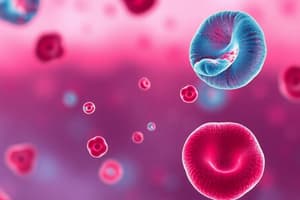Podcast
Questions and Answers
Which of the following is NOT a clinical feature associated with intravascular hemolysis?
Which of the following is NOT a clinical feature associated with intravascular hemolysis?
- Hemosiderinuria
- Anemia
- Splenomegaly (correct)
- Hemoglobinemia
What is the primary mechanism of red blood cell destruction in extravascular hemolysis?
What is the primary mechanism of red blood cell destruction in extravascular hemolysis?
- Phagocytosis by macrophages (correct)
- Intracellular parasites
- Complement activation
- Mechanical injury
Which of the following is a characteristic of hemolytic anemias?
Which of the following is a characteristic of hemolytic anemias?
- Increased red blood cell lifespan
- Decreased erythropoietin levels
- Decreased erythropoiesis
- Elevated erythropoietin levels (correct)
Anemia induced by chronic blood loss develops when:
Anemia induced by chronic blood loss develops when:
What is the normal lifespan of a red blood cell?
What is the normal lifespan of a red blood cell?
Which of the following is NOT a cause of intravascular hemolysis?
Which of the following is NOT a cause of intravascular hemolysis?
What is the name of the protein responsible for the transport of oxygen in red blood cells?
What is the name of the protein responsible for the transport of oxygen in red blood cells?
What is the most common type of hemolytic anemia?
What is the most common type of hemolytic anemia?
Flashcards
Hemolytic Anemia
Hemolytic Anemia
A condition with a shortened lifespan of red blood cells (less than 120 days).
Erythropoietin Levels
Erythropoietin Levels
Hormone levels increased due to the loss of red blood cells, stimulating production.
Erythropoiesis
Erythropoiesis
The process by which new red blood cells are produced to replace lost ones.
Extravascular Hemolysis
Extravascular Hemolysis
Signup and view all the flashcards
Intravascular Hemolysis
Intravascular Hemolysis
Signup and view all the flashcards
Clinical Features of Extravascular Hemolysis
Clinical Features of Extravascular Hemolysis
Signup and view all the flashcards
Chronic Blood Loss
Chronic Blood Loss
Signup and view all the flashcards
Diagnostic Tests
Diagnostic Tests
Signup and view all the flashcards
Study Notes
Hemolytic Anemias
- Characterized by premature destruction of red blood cells (RBCs)
- Share features such as shortened RBC life span (less than 120 days), elevated erythropoietin levels, and compensatory increase in erythropoiesis.
- Extravascular hemolysis: RBC destruction occurs within macrophages (in spleen, liver, and bone marrow)
- Triggered by age-dependent changes in RBC surface proteins recognized and removed by phagocytes.
- Can cause splenomegaly (enlarged spleen) in cases of persistent extravascular hemolysis.
- Altered RBC shape or reduced deformability causes difficulty navigating splenic sinusoids, leading to sequestration and eventual phagocytosis.
- Reduced plasma haptoglobin levels (a protein that binds free hemoglobin) due to hemoglobin leakage from phagocytes.
- Intravascular hemolysis: RBC destruction occurs within blood vessels.
- Less common than extravascular hemolysis.
- Can be caused by mechanical injury, complement fixation, intracellular parasites (e.g., malaria), or exogenous toxic factors.
- Results in hemoglobinemia (free hemoglobin in plasma), hemoglobinuria (free hemoglobin in urine), and hemosiderinuria (iron deposits in urine).
- Free hemoglobin can oxidize to methemoglobin which is brown in color, resulting in red-brown urine.
- Unconjugated hyperbilirubinemia may occur due to liver's inability to promptly process the increased bilirubin.
Chronic Blood Loss Anemia
- Anemia occurs when blood loss rate surpasses the body's ability to replenish red blood cells.
- Anemia occurs when loss exceeds marrow's regenerative capacity or when iron reserves are depleted, leading to iron deficiency anemia.
- Symptoms include shortened red blood cell life span.
- Elevated erythropoietin levels and compensatory erythropoiesis.
Studying That Suits You
Use AI to generate personalized quizzes and flashcards to suit your learning preferences.



